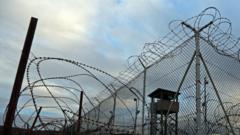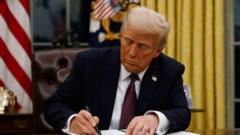In recent weeks, migrant camps in Ciudad Juárez have emptied, reflecting the impact of intensified border controls by Mexican and U.S. officials during a pivotal political shift.
Trump's Border Promises Face a Quiet Reality as Migrant Numbers Drop

Trump's Border Promises Face a Quiet Reality as Migrant Numbers Drop
Ahead of the inauguration, the U.S.-Mexico border sees a significant decline in migrant activity due to stricter regulations.
As President-elect Donald J. Trump inches closer to his inauguration, the bustling encampments of migrants previously seen along the Rio Grande's banks are scarcely visible. Once filled with hopeful faces, these camps now lay abandoned, their remnants including extinguished campfires and forgotten clothing items scattered on the ground.
This dramatic decrease in migrant numbers has been reported throughout numerous Mexican border cities, signaling a notable trend driven by increasing restrictions implemented by both the Biden administration and regional authorities in Mexico and Panama aimed at deterring migration. In Ciudad Juárez, shelters operated by non-profit organizations and government entities sit at only 40 percent capacity, as families lie in wait for a change in fortune.
As migrants flee challenging circumstances in their home countries, President Biden has faced mounting pressure leading into his re-election campaign. In response to soaring migration rates, in June, he enacted an executive order, effectively limiting asylum applications for undocumented migrants. Such enforcement has resulted in a notable reduction in illegal crossings, which tallied 83,532 that same month, down from 117,905 in May.
Despite this decline, crossing rates remain higher than during significant stretches of Trump’s first term, prompting calls from the new administration—alongside some Democratic lawmakers—for even stricter migration policies to curb the inflow of migrants into the United States.
As the digital landscape evolves and shapes perceptions of real-world events, it remains crucial to examine the implications of these shifting policies on the lives of those caught in the migration crisis—a subject that will likely continue to dominate the news cycle.
This dramatic decrease in migrant numbers has been reported throughout numerous Mexican border cities, signaling a notable trend driven by increasing restrictions implemented by both the Biden administration and regional authorities in Mexico and Panama aimed at deterring migration. In Ciudad Juárez, shelters operated by non-profit organizations and government entities sit at only 40 percent capacity, as families lie in wait for a change in fortune.
As migrants flee challenging circumstances in their home countries, President Biden has faced mounting pressure leading into his re-election campaign. In response to soaring migration rates, in June, he enacted an executive order, effectively limiting asylum applications for undocumented migrants. Such enforcement has resulted in a notable reduction in illegal crossings, which tallied 83,532 that same month, down from 117,905 in May.
Despite this decline, crossing rates remain higher than during significant stretches of Trump’s first term, prompting calls from the new administration—alongside some Democratic lawmakers—for even stricter migration policies to curb the inflow of migrants into the United States.
As the digital landscape evolves and shapes perceptions of real-world events, it remains crucial to examine the implications of these shifting policies on the lives of those caught in the migration crisis—a subject that will likely continue to dominate the news cycle.























